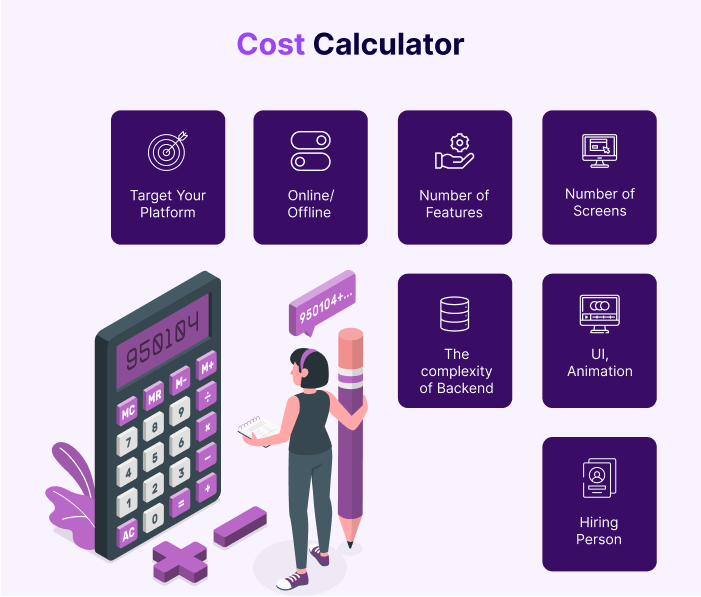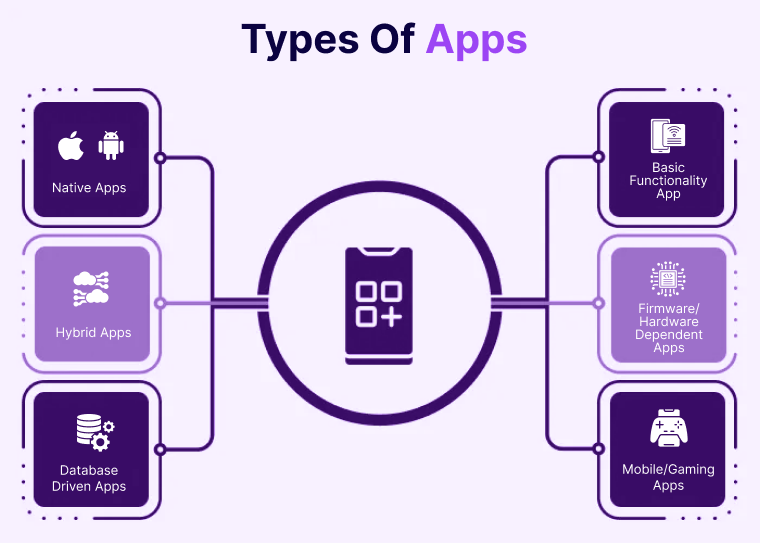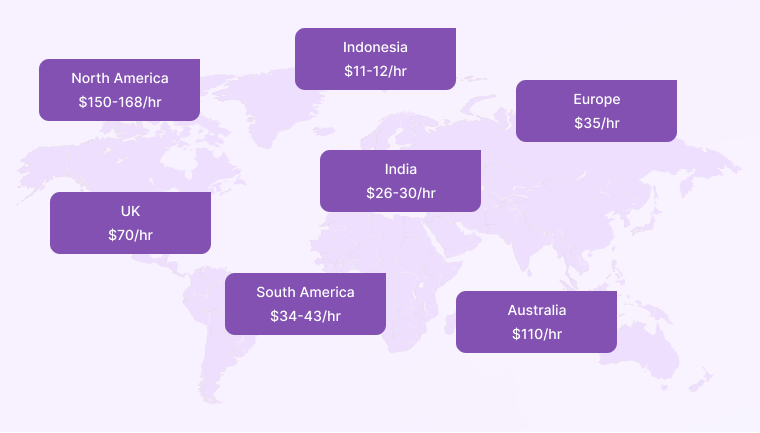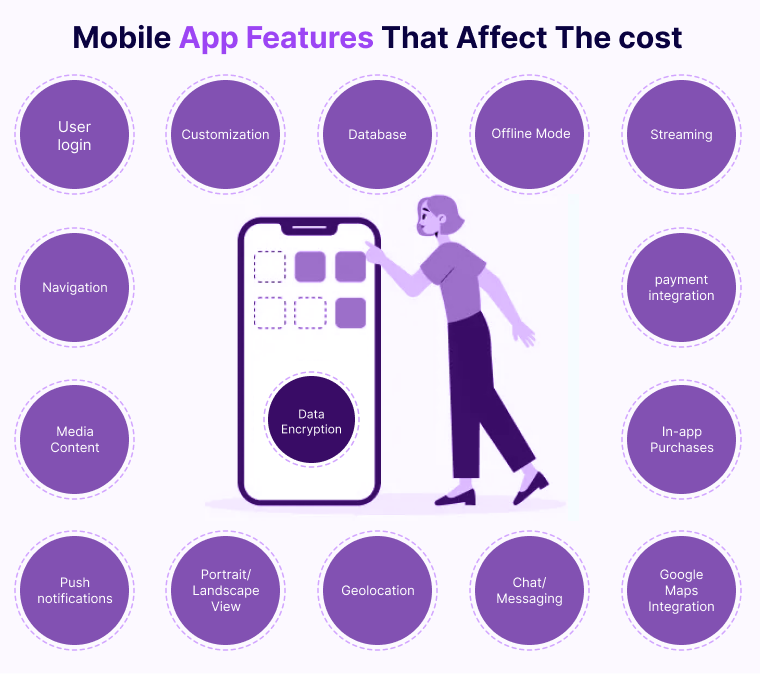Building an app for your business is the trend at its peak in the current times. But is developing an app that easy? The first question that might arise is how much would it cost to make one. Well, as per the latest market reports the cost to make an app ranges between $30,000 to $3,00,000. Further, this range varies depending on many influencing factors and specific project requirements. But then, how is this cost calculated?
In this guide, we will understand the web app development sphere with a detailed view of the global digital market, how to build an app, how to calculate its costs, related factors, and future possibilities.
The major areas that we are going to cover are:
- A detailed breakdown of app development cost
- Influencing factors of the cost
- Development Stages
- Excelling App Examples
- Tips to reduce the overall cost
So, let’s start with the most important part – Calculations.
How much does it cost to make an app?
The average cost to build an app in 2024 ranges from $150,000 to $350,000 for a complex app consisting of myriad features such as real-time updates, chatbots, etc. taking up to 8 to 18 weeks.
While the cost to build smaller apps with basic features can come to around $10,000 to $50,000 in 5 to 12 weeks. Further, this cost increases as you add more modern features & technologies like AI, AR/VR, Blockchain, etc. to make your app a futuristic, advanced app.
Some of the factors that highly govern the cost of creating a web application or a mobile application are different developers’ rates, project complexity, and the time it takes to build an app. The average cost depends upon the type of app that you want to build.
The main factors of an app cost can be understood through the following,
- Type (Mobile Game, Social Networking, Business, Shopping, etc.)
- Design (Basic, Individual, Custom)
- Platform (iOS, Windows, Android)
- Features and infrastructures
- Number of pages
Any Mobile Application Development Company would provide you with a quotation for app design and development by considering these factors.
Here’s a list of things that constitute app development costs. Let’s analyze them one by one in detail.
Things that are included in an App Cost
As you start, decide whether you want to build an app in-house or outsource it to any reliable IT service provider. Then, you need to finalize the niche of your application. The requirement of your target market and the needs of your users should be deeply explored. This analysis will help you answer multiple questions regarding your app development.
Now, how exactly the cost is calculated? There are many App Cost Calculators available online that can be used to get an approximate idea. However, a mobile application cost has a simple calculation, i.e.,
App Cost = Development Time * Hourly Rate
A simple calculation structure includes factors as described below

A factor or two of these varies depending on your choice to build an in-house app or outsource your app development. If you outsource your app development you get
- Experienced experts to work on your project
- Project management is taken care of by them
- Get current market insights for trends
- Budget-friendly
- Technical support and maintenance
However, the cost to hire dedicated developer from an app development company or a freelance becomes significant here.
Now, let us take a look at each factor that forms the overall cost of an app.
Cost of Mobile App Development as per Its Types

Native Apps
Native apps are particularly platform-based for a specific OS like iOS and Android. These apps are large and heavy apps that aim to provide the best user experience, optimization, and fast work. They are usually business apps, education apps, and entertainment apps. If you wish to target both the faction of users, you need to make two different apps which can increase your development cost.
Hybrid Apps
Hybrid apps are cross-platform apps that work on all OS best suited to reach a bigger audience. Their development and maintenance cost & time goes down as the process involves a single code that works for all the platforms. But cross-platform apps are less optimized; they lack access to APIs and do not provide a user experience similar to the native apps. They are more appropriate for small and medium communication apps, such as lifestyle apps or game apps.
Database-driven Apps
These are the apps that handle complex bulk data to operate and store directly in the device memory or on a web server. For this app to work as desired, additional features like a camera, cloud access, internet connection, or analytics tool may be required. These data-driven apps use device memory to store data libraries like various mobile dictionaries or encyclopedias.
Basic Functionality App
These apps are very fast to create and include very few or no special features at all. They are built for personal use, and these kinds of apps cannot be found in the app store. Usually, they are made to view the list of the topic – where you can click on a question and get the information about it or view another list.
Firmware/Hardware Dependent Apps
These apps access a mobile device and aim at enhancing functionalities. The functionalities include an alarm, flashlights, camera, etc. For example, AlarmMon is an app that allows the user to customize the alarm clock.
Gaming Apps
Games can be simple and advanced, including various features like 3D graphics and physics, global ratings, VR/AR support, and social media integration. Creating a more sophisticated gaming app can be expensive. Gaming apps are the most popular apps worldwide, and of course, the ones that bring in more profit.
Cost of Mobile App Development as Per Complexity
Building an app involves numerous complex factors that add to the overall cost of app development. It affects each development stage of the app. Here, we will take an in-depth view of these various categories that are involved while building an app.
A Detailed Business Analysis
“Planning without execution is just like an illusion.”
A business analyst plays an important role in determining how the design and development of the app will kick start. Properly conducted business analysis adds value to the process of building your application with a definitive plan to execute it. This process may cost you significantly depending on your project objectives.
Some vital areas that a detailed business analysis contributes to the development of the application are,
- Detail the project scope
- Market Analysis
- Road mapping the development process
- Sorting out Problems
- Defining project value
- Define and produce an effective business solution
- Gather multiple advantages under one roof
Designing Cost
One cannot forget the design cost during app development. It requires a detailed study of the niche and target audience to prepare the wireframe of your app choosing suitable graphics, animation, or other visual tools. This analysis determines the complexity of the UI/UX design features which in turn decides the price.
Here is an estimate as per the complexity of the design:
| Cost | Simple Design | Complex Design | Professional Design |
|---|---|---|---|
| Cost (hourly rate- $30) | $5,000 – $10,000 | $10,000 – $20,000 | $20,000+ |
Note: The above numbers are estimated figures and for an exact idea, you need to consult a developer who is well-experienced and skilled.
The Development Cost
The development cost is determined by the number and kind of features, functions, & required skills in your app development. Various specifications costs differently as per their complexity of development and integration. If mindfully taken care of this, the whole price of an application becomes pocket-friendly and effective.
Take an overview of some of the features and their related costs,
| App Specification | Descriptions | Comments | Cost of back-end ($) |
|---|---|---|---|
| Signup/Login | Users can register in the app by signing up for the application | Recovering password feature is also included | $850 – $1,050 |
| Payments | Users can make payments through Credit Card | Addition/Removal of CC can be done from the app to pay | $2,100 – $2,600 |
| In-App purchases | In-app purchases can be done by the user from their profile | One non-consumable In-App The subsequent app adds a percentage of the original budget |
$700 – $1,300 |
| Search | Users can search for the product from its categories | Adding the subsequent category may influence the estimate | $450 – $600 |
| User Profile | User can manage their profile | Personal Information (Name, DOB, Profile Picture, etc) | $700 – $850 |
| Chat | User can chat | List of Chat Send text messages, emojis, GIFs Push notifications for new messages and chat |
$2,400 – $3,300 |
| Report Abuse | User can report content or another user | Possible reporting reason Adding a category may hike the price |
$350 – $500 |
| Push Notification | Integration of push notifications (Hidden for users) | Adding push notifications may hike the price If a user logs out, then the push notification is disabled |
$450 – $625 |
| Analytics | Integration with analytics (Hidden for users) | Single Analytic tool (except fabric) Google analytics/ Flurry |
$100 – $200 |
| CMS: Admin Authorization | Admin can register, sign in and sign out | Sign in, Sign out | $300 – $500 |
| CMS: Admin Management | Admins can manage other admins | CRUD on administrator Full name, email |
$250 – $450 |
| CMS: User Management | Admins can manage users | Filtering or sorting our (by name, email ID) | $800 – $1,600 |
| CMS: Reported entity management | They can manage the reported entity | Adding subsequent entities may hike the percentage of the tariff It can be removed Sorting out with the number of claims |
$350 – $600 |
The price estimate above is excluding of QA specialists, project managers, and the time that a project manager takes to communicate with the client.
Cost of Project Management
The mobile app creation process inevitably includes the aspect of Project Management. Without proper project management and a responsible project manager, the accountability of the app-building process gets waned.
A project manager oversees the complete app-building process, from start to finish. Hence, around 10-15% of the total app budget should be exclusively kept for the project manager and the management process.
It is found that the budget of Project Management in the app building process charges somewhere between $1200 to $12,000, depending on the duration and app requirements.
Now, if you are planning to trim down the price of project management from the app budget, you probably are thinking wrong!
You should never cut down your project management prices as long as the project manager is accountable for his work and is responding to each event as per the needs. Although, spending a hefty amount on an unworthy project manager is not advised whatsoever.
Cost of App Release
Now comes the final action of deploying your app on the Google Play Store or iOS App Store. The cost here is to have a developer account on Play Store or App Store.
- Google Play Store app charges a service fee of $15 – $30 annually.
- Apple Store charges $99 per year.
- Also, the application builds for use within the organization, then the Google Play Store doesn’t charge anything, while the Apple Store charges $299 per year.
The list above has a few things that are chargeable and a few free things. Hire a professional expert for the development of the application and leave everything to them for effective solutions.
Post-release Expenses
Post-launch expenses are additional but equally important to consider while planning to build an app. These areas are support and maintenance wherein proper attention is required for the consistent performance and progress of the application.
A few other areas here are payment gateway integration, third-party app integration, etc. require an additional sum that is mandatory to grow and build a robust application that outreaches the maximum audience. Some notable facts about this are,
- Integrating a third-party app could attract around 4.4% additional expense with the making charge.
- Also, if you wish to add Stripe as a payment gateway to your application, then it will attract 2.9% + 30 cents for any CC/DC payment.
These factors are not included in the app development price since they are optional depending on the app requirement but are significant overall. And play an important role while preparing a budget for building an application.
Hire Freelancer vs. Agency vs. DIY for App Development
Majorly when it comes to creating an app, you have two options on the list: Mobile App Development Agencies and Freelance App Developers. Both options have their pros and cons. Also, you have a choice of doing it yourself in-house.
Cost-wise, hiring a freelance developer is a lot cheaper than hiring an agency or developing an app in-house. But working with an agency is more reliable and has more benefits than all combined which outshines the cost of hiring them.
Advantages of hiring an app agency
- Highly skilled and experienced developers, designers, programmers, and project managers.
- Help strategize your app development.
- Pay for the portfolio, project estimation, and hourly rates.
- Work is completed on time with the desired results.
But app development hourly rates differ significantly around the globe, excluding the quality that you might get. So, it is one of the Questions To Ask Before You Hire a Mobile App.
Significant disadvantages of hiring freelancers
- You have to look for designers, programmers, and testers separately.
- The communication gap between the members of the project
- There’d be no one to manage the project and take up the activities in the coordination.
There would be a lack of skills and highly experienced developers.
Advantages of Doing It Yourself
Below is the list of pros that describe the in-depth advantage of building an app by yourself, and everyone loves to do it by themselves.
- Cost-effective: It is a cost-effective option because an app design and development involves the SDLC cycle which needs planning, analysis, design, implementation, and maintenance. These life cycles have subject matter experts that you can become with proper study and research, and save a lot of money by doing it yourself.
- Online application-building platforms: There are many application-building platforms available in the market such as BuildFire, Apppie, and more that help you craft highly intuitive applications. It not only fulfills your wish to become an entrepreneur but also offers a great service to the community.
- Project Control: When you plan to build an application, you envision adding mandatory as well as exclusive features. These require control over the project which is vital for including all the major features and also maintaining the scope of the project.
As every coin has two sides, building an app by yourself also has its pros and cons. A lack of programming and coding skills may end in building a badly optimized and buggy application. Also, Subscription value is something that online application charges $10 per month or may charge around $5000 to avail of the service.
Furthermore, if you wish to learn in detail how to make a mobile app, then our blog here will help you with all steps. This will give you a detailed insight into crafting mobile applications.
App Development Cost as per Geographical Regions

The geographical location where you are getting your app developed plays a significant role in the overall cost of your app development. It could either bring an opportunity to save money or could charge you higher than expected.
The labor and skill charges differ majorly among various regions. For instance, hiring a developer or a development company from the US is higher than one from India. It may cost you an average of $70,000 approximately to craft a simple app from a moderately rated region.
Out of these thousands of companies, proper research should be done to know which company offers you relevant and more benefits. The benefits include service, maintenance, support, design and development factor, and last but not least rate per hour.
The hourly rates of developers worldwide as per the geographic location for developing an app are
| Country | iOS ($/hour) | Android ($/hour) | Approx. cost of an app |
|---|---|---|---|
| North America | $120-170 | $120-160 | $192,000 |
| UK | $60-80 | $60-80 | $120,000 |
| South America | $40-60 | $3-50 | $72,000 |
| India | $15-45 | $18-40 | $40,000 |
| Australia | $90-120 | $90-120 | $160,000 |
| Europe | $40-70 | $35-70 | $80,000 |
| Indonesia | $15-35 | $15-40 | $56,000 |
From the numbers above, you can see that the hiring rates of developers are considerably high in North America and Australia with an average of $100/per hour.
In comparison, developers from India and Indonesia are available at almost half the cost.
How Much Time Does it Take to Develop an App?
Time is essentially a crucial factor when determining the price or budget of building an app. Every development stage varies in time to complete the process. From reviewing and researching to development and testing, it may take 3-15 weeks to build an entire app.
The time to develop an app depends on the type of app you are creating, with what tools and resources, the number of developers you have outsourced/employed, and its functionalities.
Here is a short projection of what kind of apps will take and how much time, given other factors are the same for each of them.
| Type of Project | Time Taken |
|---|---|
| MVP | $3-6 weeks |
| Simple Apps | 1-month |
| Enterprise apps, consumer apps with advanced features like maps, etc. |
2-3 months |
| On-demand scalable mobile apps | 4 months and more |
The above-mentioned duration is estimated on the standard practices of working 7-9 hours a day for 5 days a week and working two development stages concurrently.
You should not forget that the app value is directly proportional to the time taken to build an app. Hence, the more time it takes, the higher will be the price.
App Development Cost as per App Features
App development is an intricate process. On average, about 80% of mobile apps take over three months to develop, and 40% require six months or maybe even more as per market research.
Besides the developers’ hourly rates, the features that you want to add to your app are significant drivers of its development cost. How much it cost to build an app depends considerably on the types, numbers, & complexity of features that are to be implemented. Each feature cost differently so you can add only the ones that you need to make your app unique.
Let’s try to understand the feature expenses to know how much it can cost to build apps.

User Login
It is the feature where app users have to register and log into the app to use it. Registering users via email or phone while signing through social media is the most popular option. Also, it creates a user profile and collects public data. This practice takes up to 30 hours and can cost around $500 – $1,000.
User Engagement
The user engagement of an app depends on the app navigation. UI architecture is the basis for an app to be built. It defines how users go from one screen to another, how they go back to the main menu, how they perform certain activities, and how fast they get their needs answered.
This architecture comprises swiping, buttons, arrows, icons, and a general admin panel that may take 60+ hours to build and may cost from $2500 to $10,000 for UI/UX designs.
Media Content
Engaging, informative media content has been shown to result in a 30%+ increase in lead conversions. It includes Wireframing, animation, graphics, images, content, etc. that broadly ranges from $100 to $20,000 and requires minimum 10hrs to 100hrs.
Almost all social networking and messaging apps need images, videos, & audio file support, including editing capabilities, filters, effects, emojis, smileys, GIFs, etc. The best example can be Video Editing App Like Magisto.
Push Notifications
It is the most demanded feature in almost 99% of apps today. These are the real-time updates that keep users updated about the activities or services related to an app.
There are several types of notifications: reminders, simple texts, images, or ones with action buttons. Also, the app logic includes- when and to whom notifications are delivered. You may need to dedicate 20 to 30 hours with pricing from $1000-$1500.
Portrait/Landscape View
The interface concept is also an integral part of any application.
It is generally the way a list of items in an app gets presented to users, also known as master/detail flow in the Android community and the portrait/landscape view for iOS.
It might take nearly 20 hours to develop this and cost approximately $500-$1000.
Geolocation
It is a crucial feature for transportation apps, dating apps, food delivery apps, business apps, restaurant apps, traveling, and many more.
It’s based on GPS, iBeacon, and real-time user permissions inclusive of Google Maps integration. And takes about 30 to 150 hours to develop and the expense rounds up to $1,250-$4000.
Chat/Messaging
Chat/Instant Messaging has become one of the important aspects of your business app. It provides you with features like support for file transfer or saving messages with an auto-deletion option or works in an offline mode, consisting of emojis and sending a notification, and much more.
You may need to invest more than 80 hours to develop, and the price from $2,000-$5,000 to become part of the latest App Marketing Trends.
In-app Purchases
This feature is optional and suitable only per your business model. In-app purchases features could be different content or items up for purchase – products, services or subscriptions, premium features, and many more. Like those in Games or unlock advanced features.
Making this feature is not that complicated, but it still can take nearly 30 hours, and the estimated price is $750-$2,000.
Payment Integration
Numerous Payment options in an app are crucial nowadays. There are many systems available to choose from – Android Pay, Google Wallet, Apple Pay, PayPal, Stripe, Braintree, and many more. It can be integrated into the app directly through gateway APIs.
The scope of this task gets determined by factors like how payments are processed, where the data is stored, and the level of PCI compliance to be provided. This needs about 50 hours or even more to develop and the price ranges from $2,500-$5,000.
Streaming
This feature gets used for cinematographic apps like Hotstar, Amazon Prime, Netflix, HBO Now, Hulu, etc.
The process includes the app logic and the data processing if the data is sent to the server in real-time and transmitted from there or via the record and send option.
It also configures the settings for users’ phone cameras and internet connection. So it takes about a minimum of 30 hours to develop these features and the charge is around $1,500.
Multi-language Support
It is helpful when an app requires to get represented in different languages for different regions.
Two significant factors that impact this task and its price are the scopes of data and UI adjustments.
It takes about 15 hours to develop this feature and costs nearly $350-750.
Offline Mode
The key feature of many apps is their availability to work in offline mode. In messaging apps, you can still see your chat history even after losing your internet connectivity.
There are a few methods for offline data storage and access to data in mobile apps- local caching, cookies, shared preferences, local storage, and SQL database.
Overall, the developers need about 40 hours to develop this, and it comes up to $2,000-$8,000 approximately.
Database
When you decide to opt for an offline mode, it would probably require a database to store data locally on a device.
Mobile app developers usually utilize a sure open-source solution to set up a database.
SQLite is a small embedded database/library that stores all the data in a single file on a device. This feature takes about 30 hours and the price is around $750-$1,500.
Customization
It is when the app control is in the hand of the user, and they can change the outlook of an app by changing the language, switching from list view to files, or full width.
The time required to develop this feature is estimated to be around 20-25 hours per screen and the price starts at $1,500.
Data Encryption
The security of private data cannot be taken lightly. Encryption of data to prevent unauthorized access is an absolute must for any mobile business app.
It means turning information into a code, and only the sender and receiver can decrypt it with keys.
For example, messages sent over Whatsapp are end-to-end encrypted which ensures the security of confidential data. This may take 20 to 80 hours.
Exploring the Structure of the Development Team
Your app development team is a major source of your concern about how much it cost to make an app. This team comprises a variety of skill sets from experienced analysts to QA specialists, Testers, and support teams.
The location of the development team that you hire is also an important factor when calculating the price to build an application. The developers sitting abroad will charge higher as compared to the developer in India.
Both will provide similar services but the geographical factor remains the hurdle for the price.
Below is the list of roles and their hourly rates depending on the region across the globe.
| Title of Employee | United States | Latin America | Eastern Europe | Asia |
|---|---|---|---|---|
| Business Analyst | $75 – $100 | $25 – $50 | $40 – $75 | $20 – $45 |
| Software Architect | $110 – $140 | $45 – $75 | $50 – $70 | $30 – $90 |
| Project Manager | $90 – $110 | $56 – $67 | $40 – $70 | $35 – $50 |
| Jr. Developer | $60 – $80 | $25 – $55 | $25 – $40 | $18 – $35 |
| Mid-level developer | $70 – $90 | $30 – $60 | $30 – $50 | $25 – $40 |
| Sr. Developer | $85– $130 | $40 – $70 | $35 – $70 | $30 – $50 |
| Lead Developer | $90 – $135 | $42 – $75 | $40 – $75 | $35 – $60 |
| Junior QA | $65 – $85 | $35 – $45 | $20 – $35 | $15 – $30 |
| Sr. Quality Assurance | $90 – $125 | $40 – $60 | $35 – $60 | $25 – $45 |
| Graphic Designer | $60 – $85 | $45 – $70 | $30 – $55 | $25 – $45 |
App Development Cost as per Platform
What does app development cost? App development has various charges of which few are avoidable and few are unavoidable as they are the pillars of app development.
Choosing a platform is important when starting your app development. Depending on factors like your business model, objectives, target audience, and location, you can build your iOS, Android mobile app, web, hybrid, or cross-platform apps.
For a starter, you can begin with a Minimal Viable Product – MVP, to test your app idea for its viability before you invest further in it.
You can start with a single platform, to begin with, that seems to serve your purpose – best for Startups or businesses with a limited budget – and later move on to utilize multiple platforms.
Let’s understand these for choosing better:
Android App Platform
Android is the most popular mobile app platform designed to build native apps on Google’s OS. Techs like Kotlin and Java are used to create these native apps. And the price ranges from $50,000 to $600,000 depending on the app’s complexity and related factors.
Pros of Crafting an Android Platform
- Cost-effective app development as compared to iOS
- Dominate mobile web traffic and fewer updates required
Cons of Building an Android Platform
- Time-consuming in the making because it takes 2-3 times longer duration than iOS
- There are ample models in Android as compared to iOS that bring multiple factors that need to be kept in mind while creating such as screen size, resolution, etc.
iOS App Platform
iOS apps are designed for iPhone OSs including MAC, iPads, and the related ecosystem. These native apps are created using Xcode, Swift, Objective-C, etc. Based on their features, they may cost from $55,000 to $600,000.
Advantages of Developing an iOS App
- Coding is the main reason why iOS is more affordable than Android because it uses Java, a programming language that required more time in coding and ultimately it increases the per-hour charge of the developer.
- It provides higher quality apps due to its strict guidelines which restrict unnecessary tool integration or design and development and attract more audience to pay for the application.
Disadvantages of Developing an iOS App
- Regular maintenance is a must requirement for iOS applications.
- The most important thing is the approval of an application on the App Store. The approval requires following Apple’s strict guidelines.
Hybrid Apps
These Hybrid apps have a single codebase and thus can function on both Android as well as iOS platforms. Flutter, Ionic, React Native, NativeScript, etc. are used to build these cross-platform apps that may range from $95,000 to $800,000.
Web App Platform
Web apps or Progressive web apps are also highly popular and cost-effective than native apps. They are built using cutting-edge technologies like Node.js, React, Angular, Vue, Python, etc. and their cost of development may range from $20,000 to $60,000.
Cost To Maintain An App
How much does it cost to build an app that continues to grow even after launching your app? You need to be ready to invest in your app support and maintenance which cannot be overlooked. It is also included as an important aspect of a contract with the IT company.
The moment you publish your app on Google Play or App Store is the moment from where the journey begins; you need to target DAU (daily active users) so that you can make people download and sustain your app usage.
The average price of maintaining an app is about 20% of the development cost per year. For example, if an app’s price is $500,000, you can estimate your maintenance charges to be $100,000.
Additional features may drive up the maintenance charges, which include:
- Powerful servers ($20-$60)
- Payment gateway ($150/month)
- Emergency maintenance depending on the nature of the emergency
- Push notification ($10/month)
- App store developer fee- $25 at Google Play and $99 at Apple Pay
App maintenance is vital for any type of application as the maintenance would update the application and keep the application bug-free. The maintenance should be done at regular intervals of time to keep the app intact and robust.
Certain factors that are included in the app maintenance are as follows:

- Upgradation of the operating system
- Updating an app with new and trending technologies
- Troubleshooting and fixing bugs
- Improvement in coding
- Updating and adding additional new features
- Controlling Stability
- Enhancement of Servers
- Scaling Application
Hidden Cost Factors to make an App
Besides the discussed costs, there are a few other hidden costs that may significantly affect your overall app development budget.
Hence, you should be aware of and consider their utility as per your project.
- 3rd Party Services – The services of Payment Gateways, Geolocation, SMS, etc. require third-party integrations that involve functional costs. Each feature cost varies individually.
- QA – If you have not partnered with an IT company for end-to-end development, then you have to pay additionally for the Quality Assurance of your app. You can hire QA specialists/Testers to check the performance and quality of your built app for a seamless experience.
- Infrastructure Cost – Items like data storage, servers, CDN, development tools, tech, & libraries form the infrastructure costs for your app.
- App Publishing Cost – To host your build apps, you may have to pay a small amount of app store fees to publish them on their platform. Google Play Store charges one-time $25 while iOS App Store charges $99/per year for the same.
- Marketing Cost – It is a very significant aspect of your app launching strategy, where you are promoting your app and getting your audience ready for it. This marketing cost can easily exceed your overall development budget 2X more.
The marketing efforts here include:
- Social Media Advertisement
- Paid Ads
- SMS and Email Marketing
- Copywriting
- PR tools, etc.
- Security – Even though Security is highly prioritized during the development of your app, you may have to invest separately in extra Security if you are building information-sensitive apps. Apps related to Banking, Finance, Documentation, Data, etc. require more security, hence, more investment.
Steps to App Development Process
Knowing how much it cost to build an app becomes advantageous if you are also aware of the app development process. It will help you get the bigger picture of the App building process.
Market Research
As you begin to work on your idea to build an app, you might want to start it by understanding your target audience with thorough market research. It will help you learn about your competitors, consumer needs, required features, etc. to measure the usability and viability of your app.
Hire an App Development Company or an App Developer
You can reach out to a reliable app development company to partner with and hire app developer for your help. You can leverage their industry expertise and these professionals will guide you from consultation to development, quality analysis, and performance of your app.
Select the Right Platform
You need to be clear on your project requirements and select the right kind of platform accordingly. Depending on your budget, you can choose just Android or iOS to start with, and later as your business expands, you can go for another one too.
MVP Development
Start your app by building an MVP – a Minimum Viable Product with just the required features to validate its utility in the intended market. It will help you regulate how your app needs to be.
App Testing
Check your app for functions and performance with the help of qualified app testers and QA specialists. It will ensure that your app is working properly, is bug-free, and is up-to-date which reduces your development cost and any extra costs at later stages.
App Submission to the App Stores
Once confident that your app is ready to go in the market, submit your app to its respective app store. The experts will make sure that your app complies with the guidelines of the Google play store or the Apple app store and then publish them.
How to Capitalize on Your Apps?
By now you must be wondering if these apps are real money-eaters. However, these apps are the best modern tools to mint money.
Besides being widely used for business expansion and automation, you can leverage these apps to capitalize on them in various ways.
Let’s look at some of the most popular ones so you can choose the ones that attract you the most.
Freemium
This is the most popular model where the users are given free access to selected features of the app. This has been shown to have attracted more users than any other model. They can be charged for full-feature access like Spotify. Further, you can also implement other revenue modes like in-app ads and features.
Subscriptions
In this model, the user has to pay a minimum amount to use the app and its features. It can be a weekly, monthly, or yearly subscription plan to be cost-effective for users as well like Netflix.
Advertisements
Another well-known method to maximize your app is through advertising. Here, you allow other products, services, or clients to promote themselves on your application and charge them for the same. A popular sample is Google Ads.
In-app Purchases
The users are encouraged to make in-app purchases for enhancing the app experience. Studies have shown $71 billion in in-app purchases in 2022. This is highly popular among gaming apps and AR/VR apps.
Sponsorships
You can collaborate with another business niche to sponsor your app in exchange for mutually agreed services, branding, marketing, or user redirection. This helps you generate a considerable amount from your app.
Monetizing Data
Quite radical yet quickly picking up the trend, exchanging data with other companies is becoming more and more lucrative. Users allow apps to collect their ‘basic and relevant’ data when accessing. This data collection can be used by other companies for analysis, market study, and research purposes in return for a friendly amount.
Real-time Examples and their Development Cost
How much does it cost to build an app? A real-time example would be a good fit for understanding the cost concept.
In recent years, the applications have flooded the market, and with over 3 billion smartphone users across the globe, approximately US$109,658m were spent on mobile games.
According to Newzoo, $159.3 billion was spent last year and this number will be $15.4 billion in almost 2 years.

The above chart shows the maximum downloads of the application which became boom last year, and building those types of applications requires a detailed analysis of cost structure.
Let’s discuss in detail a few real-time applications and their cost structure:
WhatsApp is a real-time message application that has broken all the records of downloads. The basic feature and development time are shown in the below table:
| WhatsApp MVP Development Time | ||
|---|---|---|
| Hours | ||
| Registration | 85-100 | |
| Contract | 80-110 | |
| Notification | 70-85 | |
| Chat | 190-240 | |
| GPS | 50-85 | |
| Video Calling | 225-310 | |
| Settings Adjustments | 45-60 | |
| Total time: 745-990 hours | ||
Note: The cost may vary depending upon the settings menu because it has different functions such as Profile Setting, Account Setting, Chat Setting, and Data Usage Setting.
Additionally, a team has to invest 400 – 500 hours in designing and building UI/UX, QA, Project management, and DevOps.
In total, an app like WhatsApp will cost you $150,000 – $200,000 to execute the project.
Ben Schippers, an engineer concludes that it would take approximately $500,000 and nine months to build a real-time application like Facebook which is worldwide usable and has a large community users of this application.
Facebook includes key features that are as follows:
- Registration and Signup feature
- Automatically Contact Sync
- Text/Photo/Video Sharing
- Notification
- Chat and Messaging Service
- Group and Pages feature
Facebook is a giant size web-app that serves millions of people across the globe with thousands of features and a wide variety of functions. It requires a considerable amount of time and money to build such an app.
It has numerous features and out of which there are a few functions that consume a lot of time:
- News Feed
- Video Call
- Chatting
Note: Facebook Messenger holds the Chat and Video call option but an estimated cost of building both applications is mentioned below:
As per the experts, the Facebook feed takes the maximum amount of time because there is no restriction on customization.
From posting a feed to editing, deleting, hiding, sharing, liking, and commenting, everything is on a single click but that click takes a lot of time in holding that capacity and this time indirectly costs a lot of investment while building.
Also, their new feature called “Video call and chatting,” adds approximately 500 hours. Real-time application sounds very cool and funky but building such a type of application involves a lot of time and money.
To conclude, both Facebook and Messenger applications could take around 3000 hours in building (including front-end and back-end). The average cost in North America for building such type of application would be $400,000.
How much does it cost to make an application like Instagram? Instagram is a social media platform that connects people across the globe. It is also owned by Facebook and is popular for reels and branding.
Instagram was built with the idea of a photo-sharing application but gradually, it has taken the shape of social media wherein people can share, like, chat and discover new things. It is not only a medium to connect to your kith and kin but also an online business portal where you can advertise your business and start earning.
The influence of Instagram is so much that it gave rise to a whole new marketing trend called Influencer Marketing. You can promote, buy/sell products globally and connect with millions of users across the globe.
The below chart will show the popularity of Instagram since its inception. It describes how fast an app has covered the market and gained 2.5 billion users as of 2024.

The popularity gained by Instagram is because of its features and functionalities. And, these are a combination of several factors like,
The key factors that are kept in mind while developing Instagram are as follows:
- Affordable and Economical Selection of App Development Company
- Technology Platform (Android/iOS)
- Hybrid OR Native
- Features & Functionalities
- Back-end or MBaas
Jumping to the cost, an app like Instagram could take up to $60,0000 from your pocket. The cost structure shown above may differ based on your hiring a developer preference.
The minimum charge for a developer in India is $15 – $25 per hour, which is affordable and at the same time a quality-focused rate.
The allocation of cost varies according to the feature and functionalities. There is no fixed cost associated with the making of Apps like Instagram. The more complexity and features, the higher the cost will be. So, you can plan according to that shortly.
TikTok
TikTok – A Music Video App, is a Chinese application that allows its users to record a 15-second video for their users.
Like every other application, it also has to create an MVP, and this includes:
- Basic UI
- Registration on the account
- Video Creation
- Music Library
- Posting/Uploading
- Searching
According to research, it estimates around $80K to $100K for the making of an application. On the other hand, gaining a music license would cost additional.
TikTok is an application that could attract $128K to $248K for the making of the app, as it is integrated with multiple sets of features and functions. Also, in terms of hours, it takes around 985 hours.
Spotify
It is the most preferred music player application that has approximately 207 million monthly users. This app is available across platforms – from Android to iOS users to desktops and laptops.
Spotify is built with key features that include:
- Registration
- Streaming Player
- Search Option
- Library
- Album
- Feedback
Its clone would take around 1200 hours to build and below is the table representing in detail:
| Spotify MVP Development Time | |
|---|---|
| Hours | |
| Registration | 85-100 |
| Streaming Player | 150-290 |
| Search | 100-170 |
| Library | 80-160 |
| Artist/Album | 40-50 |
| Back-end | 100-190 |
| Total time: 555-960 hours | |
North American developer charges $130/hour and that would sum up to $110K to $180K for the completion of the project.
The music-playing applications like Spotify could attract music licensing and hosting costs additionally and that could increase the cost of app development. Another way to save the cost is by using the Soundcloud route which is free of cost and users can upload their music.
Uber
Uber, is a very successful 24-hour service that offers on-demand cab service and connects drivers to riders. This type of application has two interfaces; one for riders and one for the driver.
Below is a representation of Uber features:
| Passengers | Common Features | Driver |
|---|---|---|
| Registration | Social Login | Registration |
| Selection Car Type | Push Notification | Status Update |
| Tracking | Communication | Booking |
| Rating & Feedback | Support | Navigation |
| Cost Calculator | Booking History | |
| Live Tracking | ||
| Booking History | ||
| Automatic Payment |
The above table distinguishes between Passenger and Driver, and their user interfaces. This type of application requires a payment model and hence it is integrated with the payment gateway.
Now, let’s see the user interface and its breakdown calculation with the reference of the table:
| Uber MVP Development Time (Passenger Only) | |
|---|---|
| Hours | |
| Registration | 50-70 |
| Booking | 100-121 |
| Payment | 30-50 |
| Card Details | 55-90 |
| Tracking | 71-85 |
| Notification | 40-55 |
| Ride History | 60-75 |
| Total Time: 406-546 hours | |
Here, approximately 421-526 hours may take for the design and development of the user’s side interface.
Also, there is a creator’s side layout that would take 308-382 hours to build.
| Uber MVP Development Time (Driver Only) | |
|---|---|
| Hours | |
| Registration | 50-65 |
| Status Update | 35-45 |
| Reply to Request | 65-80 |
| Tracking | 70-85 |
| Notification | 40-50 |
| Booking History | 55-65 |
| Total Time: 315- 390 hours | |
The total cost of building a Uber-like app could sum up to $120,000 to $154,000 including all the features and functionalities. This includes 60- 80 hours of development for the admin dashboard and 120-200 hours for UI/UX design.
Note: The numbers mentioned above are the analysis of experts across the globe. The numbers may vary due to the difference in opinions and calculations.
How to Cut Mobile App Development Costs?
How much it cost to build an app is clear now. But what if this cost is too high burning a considerable hole in your pockets? Of course, you would think of foregoing a few features and other elements here and there to bring it down to your budget. That’s an easy way. But why compromise on things that you need?
Here, we’ll help you with a few tips that will help you control your app development cost ensuring a high-end product in the process.
In-house or Outsourcing
Your app development project planning majorly depends on whether you decide to outsource your app development or form an in-house team.
Outsourcing is when you partner with IT industry experts for your app project. As you outsource your project, you get to leverage their expertise, access their talent, and reduce your infrastructure expenses and management hassles, while efficiently taking care of each aspect of the development process from start to end.
While building an app in-house, you may be required to conduct the hiring of suitable resources, manage them, and guide them with your requirements. It also provides more controlled development under your supervision.
So choose wisely which development staffing model interests you the most.
Partner with Full-service Companies
As you decide to outsource your app development, look out for IT companies that specialize in full-service IT solutions. They will have all types of skillsets to be able to handle all the stages of your app development from consultation to deployment and testing.
Also, it is highly recommended that you get your design and development done with the same company. As they would be there guiding your project from the start, they would know in and out of your project and can thus properly see it through its development process too.
Try to go for cross-platform development – Cross-Platform Development means creating an application for multiple platforms and providing a similar environment across the platforms. It is a legit conflict that which platform to use for your mobile app. Twitter, Facebook, Spotify, and Whatsapp, are some of the popular cross-platform mobile apps.
Multiple technologies could help you in building an application across the platform. Also, to speed up the app design and development process, you can use Unity 3D, React Native, PhoneGap, Xamarin, or similar frameworks.
Talking about the native app development platform, it is expensive and also has to write separate code for creating the app. For developing advanced applications, the use of Swift for iOS and Java for Android is recommended.
The below comparison will give you a clearer idea about the effectiveness of cross-platform development:
Cross-Platform Development
- It has Flutter, Monocross, and React-Native which is open-source and free to use.
- Kony and Appcelerator offer free plans
- Overall, the application built using the above technologies will Nativee a cross-platform environment and is also a budget-friendly option.
Native App Development
- Swift, Java, and Kotlin are some of the free programming languages
- Google Developer license charges $25/year
- Apple developer license charges $99/year for individuals and organizations, while for the organization, it charges $299/year.
Whatever the size and type of your mobile app development project, eSparkBiz can help you conquer all the platforms with mobile apps that will redefine your digital image.
Prioritize Features and Functionalities/ Start with an MVP
Plunging full-fledged into a complete mobile app development may prove to be a very costly affair. Instead, outline and prioritize the kind of app that you want to build along with the features and functions that you think it must have.
The best way to prioritize and test your app’s success in the market is by developing an MVP first. MVP or a Minimum Viable Product is the initial, functional product with limited functionalities that you want in your app.
An MVP is launched in the target market for a pilot study and tested for its viability. It provides you with opportunities to improve it just exactly as needed, add or remove features, and design it in a minimalistic way that is sure to be effective at a minimal cost.
Open-source Frameworks or Off-the-shelf Solutions
A wise software development company as a partner will guide you to reduce your costs by advising you to choose open-source frameworks or technologies or off-the-shelf solutions for your app development.
Open-source frameworks are best suited for Startups. With a limited budget, an entrepreneur could plan to develop an app with an open-source framework.
You will not have to pay to buy the technologies that you can use. Moreover, open-source frameworks are more reliable, flexible, and community-supported which helps reduces a lot of development-related expenses.
Also, choosing to work with off-the-shelf solutions that already have multiple pre-build features and most of them with customization helps you avoid investing as per the features requirement. You can leverage the expertise of your hired developer to mold and customize it as per your unique needs.
Do Not Bypass QA
You must realize that no app is without bugs and glitches and needs to be assured of its performance. Hence, under no situation omit the Quality Assurance of your mobile app.
You may think it will save you a lot of unnecessary costs. But overlooking the QA check of your apps will cost you hefty at a later stage.
Thus, involve QA specialists from the beginning of the development so your app is checked at each stage, saving you unwanted investments later on.
Plan for the Future
With the constantly evolving technology and market demand, you need to be aware of how much your app is ready to serve this volatile audience. It is wise to plan your mobile for future needs.
Go beyond meeting the current needs and set short-term and long-term goals for your mobile app development. Forsee the market trends, make calculated decisions, evaluate your customer feedback, and be flexible to adapt to the changes required to serve your users.
This will save you from having to invest again in app development in a short time. So think of the long-time possibilities of your apps.
Also Read: Top 10 Mobile App Development Companies In India
How can eSparkBiz Help in Managing your Mobile App Development Costs?
As we draw near the end of the guide, it becomes clear that the cost to build a mobile app is very subjective. Considering all the influencing factors, eSparkBiz can become your trusted partner to ease your mobile app development while ensuring cost reduction during the process.
eSparkBiz, a leading mobile app design and development company in India for 12+ years has executed multiple projects and has a long list of clients in 20+ countries. Hire Mobile App Developers from us to get your app development tailored within your budget.
eSparkBiz can help you with to name a few –
– Reliable, experienced, cost-efficient developers
– End-to-end mobile app development services
– Consultation and Market Research
– Prototyping or MVP
– QA and Testing
For availing effective IT services and in-depth knowledge about technologies, kindly contact us, and also if you want a quick quote for your project, we are always ready to help you.
Wrapping up
At the end of the guide, we are sure that you have learned a lot about the factors affecting mobile app development and how it directly has a solid impact on the overall cost of making a mobile app. So, make wise, calculated decisions as you plan your new business apps for growth.











